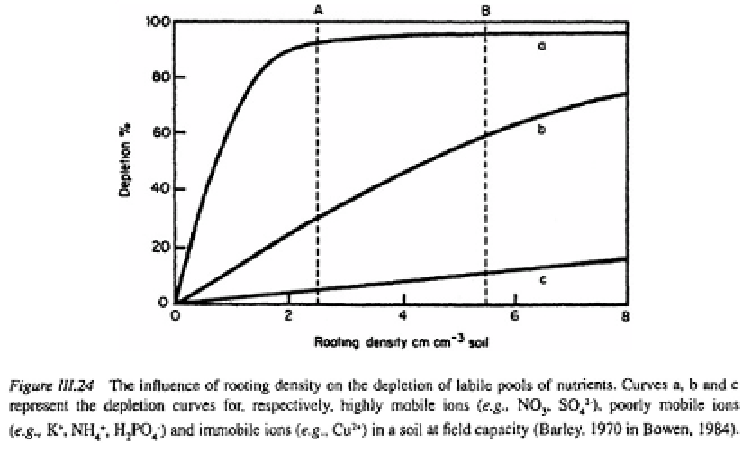Agriculture Reference
In-Depth Information
Specific allelopathic compounds in soil solutions (such as phenols) may directly
inhibit nutrient absorption by roots or impede the transformation of ammonium into
nitrate. In nutrient poor soils, two mechanisms seem to limit the production of nitrates
i.e.,
i - the low rate of ammonification due to low amounts of assimilable carbon to trig-
ger the reaction, and ii- inhibition of nitrification by water soluble substances produced
by roots (
e.g.,
Meiklejohn, 1962; Munro, 1966; Lensi
et al.,
1992). Conservation or
immobilisation of instead of nitrification are considered efficient ways to conserve
N (Marrs
et al.,
1991) (see also Chapter IV.3.2).
Absorption of nutrients by roots
Absorption of water and nutrients by plants may be active (
i.e.,
against electrochemical
or water potential gradients) or passive (
i.e.,
with the gradient)
Passive absorption is due to the accumulation of ions in a 'free' space, which is
equivalent to 20-30 % of the root volume. This 'free space' is the sum of a diffusion space,
i.e.
cell spaces from which ions may diffuse in or out freely and the 'Donnan space' in
which ions are retained by fixation and exchange due to the negative charges borne by
cell wall constituents and cytoplasmic proteins (Callot
et al.,
1982). The maximum
concentrations attainable by passive absorption may exceed those in the soil solution
by this exchange process as the exchange occurs on the basis of equality of chemical
potentials rather than concentrations. The total amount of cations that roots are able to
absorb through this 'Donnan equilibrium' is called the cation exchange capacity of roots.
Low cation exchange of roots, as for example, in the Gramineae, is considered an
adaptive advantage as anion diffusion occurs more readily. If the concentration gradients
are reversed, ions which have been passively absorbed are desorbed and move towards
the external solution.


